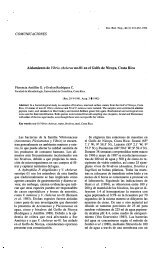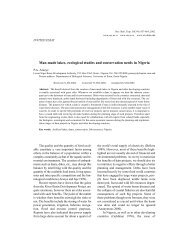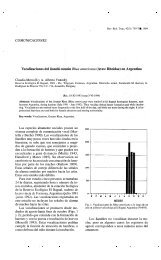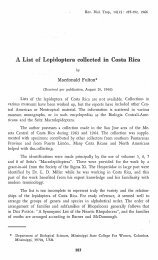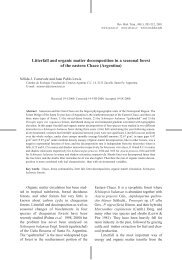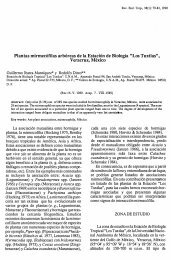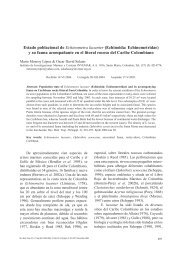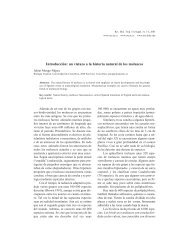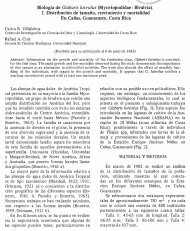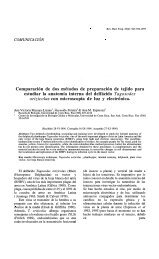a new spider crab from Gorgona Island, Colombia Henry von Prahl ...
a new spider crab from Gorgona Island, Colombia Henry von Prahl ...
a new spider crab from Gorgona Island, Colombia Henry von Prahl ...
Create successful ePaper yourself
Turn your PDF publications into a flip-book with our unique Google optimized e-Paper software.
COMUNICACIONES Rev. Bio!. Trop., 30(2): 169-170, 1982<br />
Tyche sulae (Crustacea : Majidae)<br />
a <strong>new</strong> <strong>spider</strong> <strong>crab</strong> <strong>from</strong> <strong>Gorgona</strong> <strong>Island</strong>, <strong>Colombia</strong><br />
<strong>Henry</strong> <strong>von</strong> <strong>Prahl</strong><br />
Departamento de Biología, Universidad del Valle, Call, <strong>Colombia</strong><br />
Felipe Guhl .' .<br />
Laboratorio d.e Invertebrados Tropicales, Universidad de los Andes, Bogota, <strong>Colombia</strong><br />
(Received for publlcation September 21, 1981)<br />
Resumen: Se reporta una nueva especie de cangrejo majido, Tych� sulae, . colectad � en la Isla de <strong>Gorgona</strong> en el<br />
Pacífico de <strong>Colombia</strong>. La nueva especie se diferencia de las demas especies conocidas por la estructura de sus<br />
gonopodios, que se caracterizan por presentar una acentuada cresta, armada de una fuerte espina.<br />
The genus Tyche ' Bell has a wide geographical<br />
distribution, ranging <strong>from</strong> Agua Verde<br />
Bay in the Gulf of California, to Esmeraldas,<br />
Ecuador, including the islands of Galápagos and<br />
CIarion (Garth, 1958). Tyche lame/lifrons Bell,<br />
1835 was considered for a long time the only<br />
species (Rathbun, 1925) until Garth (1958)<br />
described Ty che clarionensis and T.<br />
galapagensis.<br />
During the Expedition Sula III (1979,<br />
Colciencias-Uniandes) to <strong>Gorgona</strong> <strong>Island</strong>, two<br />
adult <strong>crab</strong>s were collected. Their external<br />
anatomy is similar to that of Tyche<br />
lamellifrons, but the gonopods are different.<br />
Based on these differences, the <strong>crab</strong>s are considered<br />
as an undescribed species.<br />
Material examined : Male holotype and one<br />
paratype, deposited in the Invertebrate Collection,<br />
of the Universidad de los Andes, Bogotá,<br />
<strong>Colombia</strong>.<br />
Measurements -male holotype:<br />
Length of rostrum<br />
Width of rostrum<br />
Length of carapace<br />
Hepatic width of carapace<br />
Branchial width of carapace<br />
Length of chela<br />
Length of gonopods (first pleopod)<br />
2.5 mm<br />
3.0 mm<br />
17.0 mm<br />
9.0 mm<br />
10.5 mm<br />
5.0 mm<br />
3.2 mm<br />
169<br />
Family MAJIDAE Samonelle, 1819<br />
Genus Tyche Bell, 1835<br />
Tyche sulae <strong>new</strong> species<br />
(Fig. 1)<br />
Description: Carapace broad at hepatic level,<br />
with gastric and cardiac region elevated ; branquial<br />
region depressed. Frontal regio n with four<br />
horns, the two parallel rostral horns exceed the<br />
preorbital horns, and present two spinous projections,<br />
extending inwards at the midpoint of<br />
each horno Preorbital spines divergent. The posterior<br />
projection of the orbit and the hepatic<br />
lobe form a flattened leaflike process that cancels<br />
the eyestalk. External maxilliped broad,<br />
smooth, and inflated. Cheliped more robust<br />
than walking legs; merus cylindrical. First ambulatory<br />
legs longer than the cephalothorax, covered<br />
with clusters of hooked hairs, dactyle<br />
curved, with corneus tips. Gonopods straight,<br />
with two anterior flaps, one well-developed,<br />
forming a crest, armed with a strong spine, directed<br />
forward. The terminal orifice is not cancelled<br />
by the flaps. The concave margin presents<br />
a row of papillae (Fig. 2).<br />
Color in Iife: Carapace and quelipeds Sudan<br />
brown.<br />
Habitat : On hard substrate, down to 10 m,<br />
associated with algae of the genera Ulva and
170<br />
Fig. l. Dorsal view of Tyche sulae, <strong>new</strong> species.<br />
Padina. The holotype was captured with pie ces<br />
of algae anchored in the hooked rostral and<br />
walking leg hairs, which permits the <strong>crab</strong> to<br />
camouflage itself with the substrate.<br />
Remarks: The name sulae was given in memory<br />
of the Sula Expeditions to <strong>Gorgona</strong> <strong>Island</strong>.<br />
The general anatomy of Tyche sulae n.sp. is<br />
similar to that of T. lamellifrons. According to<br />
Garth (1958) HIt is the maxilliped and pleopods<br />
upon which the <strong>new</strong> species should rest, rather<br />
than relative length of rostral to preorbital<br />
horns". Tyche galapagensis (Fig. 3a) has a<br />
curved gonopod, with a triangular shaped<br />
opening and a rudimentary protecting flap, not<br />
extending to the tipo Tyche lamellifrons (Fig.<br />
3b) has a gonopod provided with a rounded<br />
flap, which scarcely cancels the terminal oririce.<br />
The concave border has a row of papillae.<br />
Tyche clarionensis (Fig. 3c) has a gonopod with<br />
a fold along the convex margin terminating in a<br />
square-cut flap which cancells the terminal<br />
opening. The concave margin has a row of<br />
papillae (Garth, 1958).<br />
Comparing these descriptions and drawings<br />
of the different gonopods of the known species,<br />
with those of Tyche sulae n.sp. (Figs. 2, and<br />
3d), the general shape is straighter and not<br />
curved at the end. The crest flap has a strong<br />
and well-developed spine, directed forward on<br />
the anterior border, a structure not observed in<br />
the other gonopods. Dr. J.S. Garth (personal<br />
communication) examined the known species<br />
and could not detect spines on the flaps. The<br />
flaps do not cancel the genital orifice. We consider<br />
that these differences in the shape and<br />
REVISTA DE BIOLOGIA TROPICAL<br />
Fig. 2. Right fl fst pleopod (gonopod) of Tyche sulae<br />
n.sp. a. Spine, b. Papillae.<br />
Fig. 3. Right fl fst pleopod (gonopods) of:<br />
a. Tyche galapagensis Garth, 1958.<br />
b. Tyche lamel/ifrons Bell, 1835.<br />
C. Tyche clarionensis Garth, 1958.<br />
d. Tyche sulae, <strong>new</strong> species<br />
b<br />
d<br />
structure of the gonopods justify the identification<br />
of this <strong>crab</strong> as a <strong>new</strong> species.<br />
REFERENCES<br />
Garth, J.S. 1958. Brachyura of the Pacific Coast of<br />
America, Oxyrhyncha. Allan Hancock Pacific Expedition.<br />
21 (1): XII, 499 p.<br />
Rathbun, M.J. 1925. The Spider Crabs of America.<br />
Bull. U.S. Nat. Mus. No. 129,613 p., 283 pis., 153<br />
text-figs.




